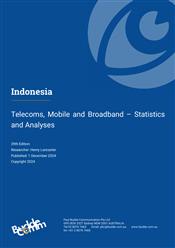Indonesia Telecoms Market Report
Telecoms, Mobile and Broadband - Statistics and Analyses

Progress continues on Indonesia’s expanding satellite and submarine cable platforms
Indonesia comprises the world’s largest archipelago, and as such the country faces a range of obstacles in terms of enabling widespread access to quality telecom services covering its population. Geographical challenges have been exacerbated by a variety of social, political, and economic problems over the years, which have kept the country’s wealth distributed very thinly.
Many islands are sparsely populated, which has rendered the deployment of fixed-line infrastructure on a broad scale largely impractical. What fixed infrastructure does exist remains concentrated around major urban centres. The relatively low broadband penetration rate is partly due to under-investment by the previously state-owned incumbent Telkom, though in recent years more effort has been made to address poor connectivity in outlying areas, where a good proportion of the population resides with limited internet coverage. There has been renewed activity in laying out fibre cables (though mostly again concentrated in built-up areas, where the return on investment is more secure), but the bundling of fixed-line telephony with TV and internet services will see the country’s teledensity stabilise for the near future. For all that, Indonesia’s telecom sector is largely focussed on mobile connectivity. In what has become a highly competitive market, mobile penetration reached 140% and is projected to exceed continued to increase at a steady, though slow, rate over the next five years.
With LTE being practically universally available, the major mobile operators have been busy trialling and launching 5G services in selected areas. Telkomsel was the first to go live, in Jakarta in May 2021, followed by IOH launch in Solo shortly afterwards. However, the rollout of 5G is being hampered by the lack of available suitable spectrum. Telkomsel was obliged to launch services using limited spectrum in the 2.3-2.4GHz band, which is only supported by a small number of handsets. Much of the LTE spectrum had to be re-farmed from broadcasting services. Telkomsel was able to alleviate some of the pressure on its limited spectrum holdings after having secured 20MHz of spectrum in the 2.1GHz band at auction in November 2022. The same refarming process is likely to be considered in order for the operators to expand 5G into its core frequency bands (3.3-4.2GHz).
Key Developments
- Telkomsel and Indosat Ooredoo expand 5G services, signs agreement to merge with IndiHome.
- Indonesia preps for the launch of the SATRIA-1 satellite.
- Mitratel sets aside IDR1 trillion for new towers in underdeveloped and regional areas of the country.
- Progress continues on the Bifrost cable system connecting the US West Coast with Indonesia, the Philippines, and Singapore.
- Telkom starts to build its second Hyperscale Data Center (HDC).
- Telkomsel secures 20MHz of spectrum in the 2.1GHz band at auction.
- Ooredoo and CK Hutchison complete the merger of their respective Indonesian mobile operations, forming Indosat Ooredoo Hutchison (IOH).
- IOH contracts ZTE to develop a 5G transport network.
- Report update includes the regulator's market data for 2021, telcos' operating and financial data to Q4 2022, updated Telecom Maturity Index charts and analyses, recent market developments.
Key companies mentioned in this report:
Telkom, Indosat Ooredoo, Bakrie Telecom, Telkomsel, XL Axiata, 3 Indonesia, Smartfren, STI, Internux (Bolt!), TelkomNet, Link Net, MNC Kabel Mediacom, Biznet Networks, MyRepublic.
Related Reports
- Asia - Mobile Infrastructure and Mobile Broadband
- Asia - Fixed Broadband Market - Statistics and Analyses
- Asia - Mobile Network Operators and MVNOs
- Indonesia - Data Centre Market
- Myanmar (Burma) - Telecoms, Mobile and Broadband - Statistics and Analyses
- Uzbekistan - Telecoms, Mobile and Broadband - Statistics and Analyses
- Taiwan - Telecoms, Mobile and Broadband - Statistics and Analyses
- China - Telecoms, Mobile and Broadband - Statistics and Analyses
- South Korea - Telecoms, Mobile and Broadband - Statistics and Analyses
Share this Report
TMT Intelligence
A platform to scale your intelligence tasks
Monitor critical insights with our AI-powered Market Intelligence Platform gathering and analyzing intelligence in real time. With AI trained to spot emerging trends and detect new strategic opportunities, our clients use TMT Intelligence to accelerate their growth.
If you want to know more about it, please see:
Research Methodology
BuddeComm's strategic business reports contain a combination of both primary and secondary research statistics, analyses written by our senior analysts supported by a network of experts, industry contacts and researchers from around the world as well as our own scenario forecasts.
For more details, please see:
More than 4,000 customers from 140 countries utilise BuddeComm Research
Are you interested in BuddeComm's Custom Research Service?
Hot Topics
News & Views
Have the latest telecommunications industry news delivered to your inbox by subscribing to BuddeComm's weekly newsletter.